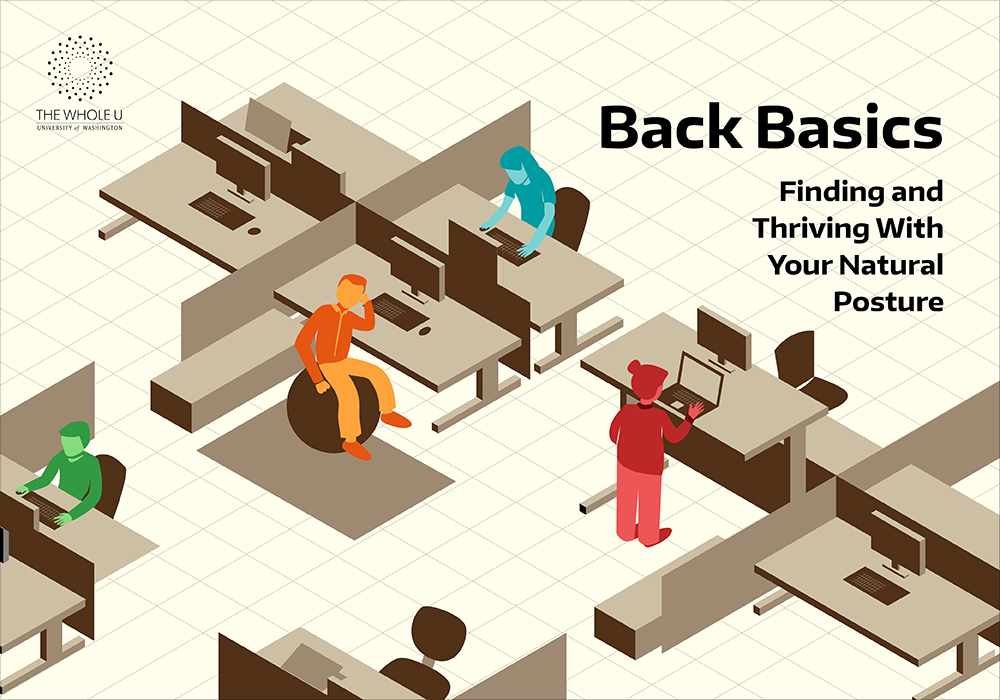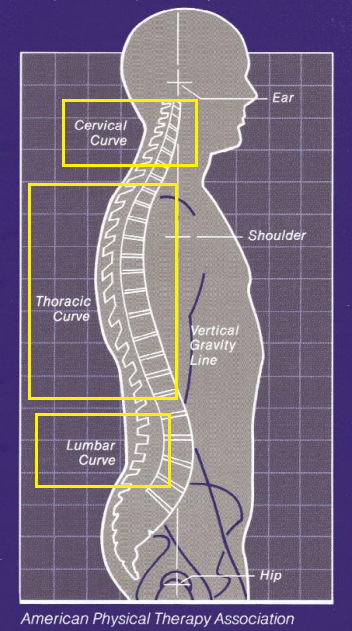
Improve Your Posture: Learn the 3 Curves of the Spine
Stand up straight, keep your head up, and take pride in yourself.
That’s what a man named Luther used to tell my dad, a slouching 19-year-old, when they served in the military together. It was 1973, at Clark Air Base in the Philippines, and Luther didn’t put up with poor posture.
It worked: I don’t think my dad has slouched since. He’s 6-foot-2, but people often think he’s taller than that. His posture translates to a confident presence, the bedrock of a 30-year career in sales.
Most of us aren’t like my dad and Luther. We slide back in our chairs and slump over our desks. We look shorter than we actually are, not taller. We could stand to gain some confidence — if we stood a little better.
The price of bad posture is more than pride. Slouching puts tremendous stress on our bodies over time. A third of Americans over 50 have chronic back or neck problems, and people of all ages feel stiff after long periods of hunched sitting.
“If you have poor posture, your bones are not properly aligned, and your muscles, joints, and ligaments take more strain than nature intended,” says the American Physical Therapy Association (APTA).
These micro-traumas add up. Tendons gradually rupture. The discs in our back struggle to absorb shock. Unlike an acute event like an ankle sprain, these injuries take a long time to heal. Some of them may be irreversible.
Luther’s advice to my dad worked, but it was a little misleading. We tell people to stand up “straight,” but the spine itself isn’t a straight line. Instead, it’s an S-shape made up of three curves. APTA defines “good posture” as a balanced alignment of these curves.
Besides improving your long-term health, learning the three sections of the spine will make you look and feel more confident when meeting new people, presenting in front of groups, and posing in photographs. Whether you’re sitting down or standing up, try to apply what you learn as we traverse the vertebrae.
The Three Curves of the Spine
 Let’s start like a Quentin Tarantino movie: in the middle. The thoracic curve is named for the thorax, the area between the neck and the abs. Photographer Roberto Valenzuela calls the thoracic curve “the culprit for most of the problems with a pose, because it is the part of the spine responsible for hunching and slouching.”
Let’s start like a Quentin Tarantino movie: in the middle. The thoracic curve is named for the thorax, the area between the neck and the abs. Photographer Roberto Valenzuela calls the thoracic curve “the culprit for most of the problems with a pose, because it is the part of the spine responsible for hunching and slouching.”
The solution? Stretch your thoracic curve up to the ceiling. This is the stereotypical “good” posture — the one you jump into when someone tells you to stop slouching. But this is just the first step. Puff out your chest a little if it helps you, but avoid “winging” your shoulder blades back (like in the military stance).
Now look down to the lumbar curve, which connects your abs to your lower body. These vertebrae should be slightly curled inward. We lose this natural form when we lean back in our chairs and slide our bottoms forward. You can recover the curve by yanking your tailbone back and pushing your belly button forward.
Overcompensating will lead to lumbar hyperlordosis. To measure your curve, lean your back against a wall. Your thoracic curve and tailbone should be resting on the surface, but your lumbar curve should not be touching the wall. Put your hand in the gap. Your fingers should be able to fit, but if your full hand slides in without resistance, your curve is too steep.
Those two adjustments can do wonders for your posture and, by extension, your presence. But that’s not all. The cervical curve, better known as your neck, should also be slightly curved inward to complete the S-shape. Leaning too far forward leads to a hunched-over look, while leaning too far back scrunches your neck.
This is where the straight line comes in: When you look at the side view of someone standing with proper posture, a straight line should run from their ear to their ankle. If your line is uneven, the cervical curve may be to blame.
Here’s something you already know: Good posture doesn’t feel good at first. It might even feel like you’re stretching. That’s not a bad thing, as long as it’s not straining your muscles. You need to build up your back. For strong muscles and joints, try weightlifting or yoga. Athletes often have excellent posture because they do squats, deadlifts, and other moves that require a natural arch of the back.
Set Up Your Desk for Success
I reached out to Peter W. Johnson, a professor in the Department of Environmental & Occupational Health Sciences, to learn about ergonomic workstations. Johnson has collaborated with Logitech and Microsoft to design keyboards and mice.
“I worked on my doctorate back in late ’80s when we had no idea what was causing all these repetitive motion injuries,” he says. “People were walking around with wrist braces on both hands from intensive keyboard use.”
Johnson says the surface of your workstation should be just below your elbows: “If you hold your forearm out like you’re going to shake somebody’s hand, that’s your most natural posture.”
Your feet should be flat on the floor and your thighs comfortably supported by the seat cushion. If your workstation isn’t height-adjustable, you’ll need to raise your chair to make up the difference. A footrest can fill the gap created below.
We deviate from the handshake position even when our desks are properly leveled. Keyboards and mice require us to rotate our palms downward, and when we type, we bend our wrists outward at the pinky to line them up with the middle row of keys. Ergonomic keyboards can reduce that outward bending and improve your wrist posture.
Don’t overlook the mouse: Johnson says we use it 2-4 times more often than we type, even when we’re in a word or email application. Try to keep it close to the handshake position.
Finally, adjust the height of your monitor. The top of your screen should be just below eye level, that way you can keep your head in a neutral position over the spine, instead of bending it forward. “Your head is a high-performance bowling ball,” Johnson says. “It weighs around eight pounds. If you have it bent forward or looking to the side, that can put a lot of stress on your neck, shoulders, and spine.”
Laptops are poorly designed in this respect — you always have to look down at them. “I guess back in the day they were more for snacking or periodic use,” Johnson says. “Now we have our full meals in front of our laptops, meaning we use them almost all the time.”
If you use a laptop for work, elevate it with a stand or a few stacks of paper. Opt for an external keyboard and mouse. And speaking of snacks: reserve your tablets for small sessions. Staring down at them for long periods of time can compromise your head and neck.
Mixing It Up, Moving Around
Once you master the S-shape, you can apply it to a variety of positions. Good posture doesn’t mean folding into a right angle and stuffing yourself inside a chair all day. Johnson recommends switching up your position once an hour. As long as your curves are aligned, you’re good.
Stand when you can. The spine maintains its natural curves better when you’re on your feet versus on your seat. Put your printer across the room from your desk. Walk to your colleague’s desk instead of sending an email. Cave in to the craze and buy a fitness tracker.
Dr. June Spector, a colleague of Johnson’s in Environmental & Occupational Health Sciences, echoed the importance of getting out of your chair.
“Yes, posture is important. But above all, inactivity — being in one position, or even a small number of positions — is probably not the best idea,” Spector says. “Moving is helpful because it resets you. It ensures that you’re using muscles that you might not always be using.”
Patients have told Spector that moving “resets” them both physically and mentally. It gets their blood moving, their muscles loose, and their mind on something else. In that way, it’s a cycle: Bad posture can make you tired and stiff, which traps you in your seat. A healthy sitting posture will keep you energized for activity breaks, which in turn make you more alert at your desk.
Ultimately, the key to good posture is holding yourself accountable. Chances are you don’t have someone who berates you about your back on a daily basis. You’ll have to be that person.
Stop to check out your reflection in windows or full-body mirrors. Remember the three curves, and look for the straight line from your ear to your ankle. Take a deep breath and stand tall as your lungs fill with air. What would Luther say?